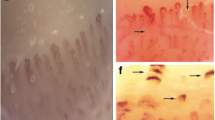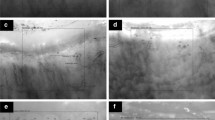Abstract
This study was conducted to evaluate the diagnostic accuracy of power Doppler ultrasonography (PDU) for differentiating secondary from primary Raynaud’s phenomenon (RP), and also compared PDU with nailfold capillaroscopy (NFC) for the assessment of microvascularity in undifferentiated connective tissue disease (UCTD) patients with RP. Microvascularity in the nailfold and finger tip was evaluated using PDU with cold challenge, and the findings of PDU were classified according to the qualitative grading system before and after cold challenge. NFC was performed at the same day in all persons. The results of PDU were compared with the clinical, laboratory data, and the findings of NFC. The 14 UCTD patients with RP were included in our study. Seven patients were suspected of secondary RP in NFC examination, thus NFC yielded a correct classification into secondary RP in 50% of the UCTD patients. The PDU finding of pattern II, which is regarded as the finding of secondary RP, was observed in 12 UCTD patients with RP. Thus, PDU yielded a correct classification into secondary RP in 86% of UCTD patients. In conclusion, we confirmed that PDU has a higher correct classification rate than NFC for the diagnosing of secondary RP in UCTD patients. Our results suggest that PDU has better accuracy than NFC in differentiating secondary from primary RP, and PDU is more useful in assessing microvascular abnormalities in UCTD patients with RP.

Similar content being viewed by others
References
LeRoy EC, Maricq HR, Kahaleh MB (1980) Undifferentiated connective tissue syndromes. Arthritis Rheum 23:341–343
Mosca M, Tavoni A, Neri R, Bencivelli W, Bombardieri S (1998) Undifferentiated connective tissue diseases: the clinical and serological profiles in 91 patients followed for at least 1 year. Lupus 7:95–100
Mosca M, Neri R, Bombardieri S (1999) Undifferentiated connective tissue diseases (UCTD): a review of the literature and a proposal for preliminary classification criteria. Clin Exp Rheumatol 17:615–620
Danieli MG, Fraticelli P, Salvi A, Gabrielli A, Danieli G (1998) Undifferentiated connective tissue disease: natural history and evolution into definite CTD assessed in 84 patients initially diagnosed as early UCTD. Clin Rheumatol 17:195–201
De Angelis R, Cerioni A, Del Medico P, Blasetti P (2005) Raynaud’s phenomenon in undifferentiated connective tissue disease (UCTD). Clin Rheumatol 24:145–151
Lally EV (1992) Raynaud’s phenomenon. Curr Opin Rheumatol 4:825–836
Wigley FM (2002) Clinical practice. Raynaud’s phenomenon. N Engl J Med 347:1001–1008
Naidu S, Baskerville PA, Goss DE, Roberts VC (1994) Raynaud’s phenomenon and cold stress testing: a new approach. Eur J Vasc Surg 8:567–573
Keberle M, Tony HP, Jahns R, Hau M, Haerten R, Jenett M (2000) Assessment of microvascular changes in Raynaud’s phenomenon and connective tissue disease using colour Doppler ultrasound. Rheumatology 39:1206–1213
Lee SI, Lee SY, Yoo WH (2006) The usefulness of power Doppler ultrasonography in differentiating primary and secondary Raynaud’s phenomenon. Clin Rheumatol 25:814–818
Mosca M, Neri R, Bencivelli W, Tavoni A, Bombardieri S (2002) Undifferentiated connective tissue diseases: analysis of 83 patients with a minimum follow-up of 5 years. J Rheumatol 29:2345–2349
Newman JS, Laing TJ, McCarthy CJ, Adler RS (1996) Power Doppler sonography of synovitis: assessment of therapeutic response—preliminary observations. Radiology 198:582–584
Anders HJ, Sigl T, Schattenkirchner M (2001) Differentiation between primary and secondary Raynaud’s phenomenon: a prospective study comparing nailfold capillaroscopy using an ophthalmoscope or stereomicroscope. Ann Rheum Dis 60:407–409
LeRoy EC, Medsger TA Jr (1992) Raynaud’s phenomenon: a proposal for classification. Clin Exp Rheumatol 10:485–488
Harper FE, Maricq HR, Turner RE, Lidman RW, Leroy EC (1982) A prospective study of Raynaud phenomenon and early connective tissue disease. A five-year report. Am J Med 72:883–888
Maricq HR, Harper FE, Khan MM, Tan EM, LeRoy EC (1983) Microvascular abnormalities as possible predictors of disease subsets in Raynaud phenomenon and early connective tissue disease. Clin Exp Rheumatol 1:195–205
Zufferey P, Depairon M, Chamot AM, Monti M (1992) Prognostic significance of nailfold capillary microscopy in patients with Raynaud’s phenomenon and scleroderma-pattern abnormalities. A six-year follow-up study. Clin Rheumatol 11:536–541
De Angelis R, Del Medico P, Blasetti P, Cervini C (2003) Raynaud’s phenomenon: clinical spectrum of 118 patients. Clin Rheumatol 22:279–284
Author information
Authors and Affiliations
Corresponding author
Additional information
This study was supported by research funds from Chosun University Hospital, 2007.
Rights and permissions
About this article
Cite this article
Kim, SH., Kim, HO., Jeong, YG. et al. The diagnostic accuracy of power Doppler ultrasonography for differentiating secondary from primary Raynaud’s phenomenon in undifferentiated connective tissue disease. Clin Rheumatol 27, 783–786 (2008). https://doi.org/10.1007/s10067-008-0851-y
Received:
Accepted:
Published:
Issue Date:
DOI: https://doi.org/10.1007/s10067-008-0851-y




